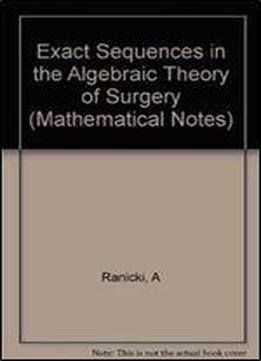
Exact Sequences In The Algebraic Theory Of Surgery
by Andrew Ranicki /
2017 / English / DjVu
4.5 MB Download
Review
One of the principal aims of surgery theory is to classify the homotopy types of manifolds using tools from algebra and topology. The algebraic approach is emphasized in this book, and it gives the reader a good overview of the subject, as it was known at the time of publication.
If one is given a closed topological manifold of dimension N, then for a given integer k, the N-k cohomology is isomorphic to the k-homology of the manifold. This isomorphism is called Poincare duality. A space X will be homotopy equivalent to an N-dimensional manifold if X is a N-dimensional Poincare duality space, i.e. the N-k cohomology of the space is isomorphic to the k homology of the space. The author defines the 'topological structure set' to be the set of equivalence classes of pairs (N-dimensional manifold M, homotopy equivalence h: M -> X), where two pairs (M, h) and (M, h') are equivalent if one can find a homeomorphism F from M to M' such that h'F is equivalent to h. Surgery theory then attempts to find out if a Poincare complex X is homotopy equivalent to a manifold, by computing the topological structure set in terms of the algebraic topology of X.
One approach to deciding if a Poincare complex is homotopy equivalent to a manifold is due to the mathematicians Felix Browder, S.P. Novikov, C.T.C Wall, and Dennis Sullivan. This is now known as obstruction theory, and involves the use of two concepts: the primary topological K-theory obstruction, and a secondary algebraic L-theory obstruction. The latter is defined if the primary obstruction vanishes. These are reviewed in the book, and the author shows how, for dimensions greater than or equal to 5, that the non-emptiness of the topological structure set is necessary and sufficient for the primary surgery obstruction to be zero.
The author also discusses the use of the algebraic L-groups, due to the mathematicians Kervaire and John Milnor, in the surgery classification of exotic spheres. Their work could essentially be thought of as the origin of surgery theory. The author elaborates on just what is involved in making their ideas applicable to a purely algebraic setting, which is now classified as 'algebraic L-theory'. The author does this in the context of rings that possess an involution operation (thus the theory is sometimes called hermitian K-theory), and defines an n-dimensional algebraic Poincare complex over these rings (in topology the ring is the group ring of the fundamental group). In zero dimensions, these complexes reduce to non-singular quadratic forms over the ring. He then generalizes Poincare-Lefschetz duality to obtain an n-dimensional algebraic Poincare pair over the ring, which is essentially a pair of chain complexes together with a self-dual chain equivalence. This gives a kind of abstract cobordism theory, in which one can speak of n-dimensional algebraic Poincare complexes as cobordant if their difference is the boundary of an (n+1)-dimensional algebraic Poincare pair.
The author's primary aim in the book then is to generalize the topological setting to a purely algebraic one. In the topological setting, the symmetric and quadratic L-groups generalize the K-groups in the sense that these L-groups are related to the Witt groups in the same way that the K-groups are related to the projective class group. In algebraic L-theory then, the goal is to prove that the symmetric and quadratic forms are hyperbolic and determine how many ways this can be done. This is to be compared with the situation in algebraic K-theory, wherein one must determine how many ways a finitely generated projective module is free.











